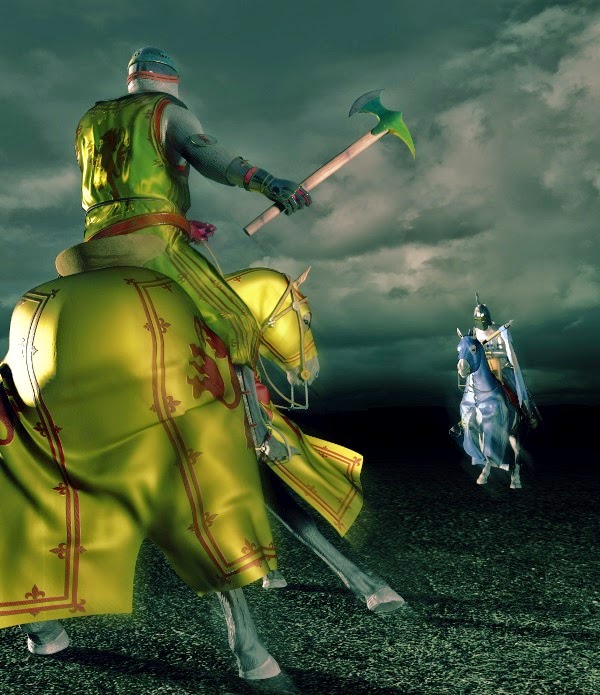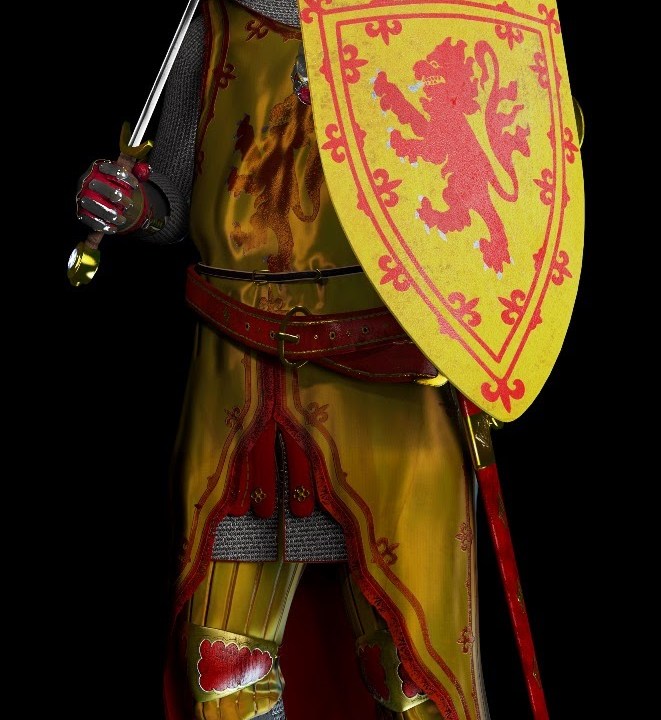I’ve long wished there was an AR app for Civil War Battlefields that would allow me to overlay video of reenactors on the actual landscapes of Gettysburg, Antietam, etc. (Maybe with a little less gore than would be strictly accurate.)Maybe that’s why the Battle of Bannockburn project caught
my eye—it takes a different ingenious approach to bringing the history of warfare to life with technology. While I’m at the Alliance annual meeting in Seattle this week, I invited Tom Ingrey-Counter, Interpretation Sub-Project Manager for the Battle of Bannockburn at the National Trust for Scotland, to share more about this project.
 |
Meet Robert the Bruce
in 3D |
The National Trust for Scotland preserves a collection of monuments on the summit of a hill, near Stirling. They commemorate the thousands of soldiers – the servicemen of their day – who lost their lives at the Battle of Bannockburn. However, the debate over exactly what happened, and where,during those two days in June 1314, continues. The area in question is unwieldy and encroached upon by houses. And not one scrap of archaeological evidence of the fight has been uncovered.
The interpretative scheme
The absence of an archaeological record was one of the creative challenges faced by interpretative designers Bright White, the York-based company employed to deliver the new interpretation. Rather than working with physical objects from the archaeological record, they worked with the historical record and introduced gameplay dynamics into the visit. They invented an experience – housed within a discrete new building by Reiach and Hall architects – which places the visitor in a compelling immersive 3D visualisation of the Scots and English armies on the brink of battle: Human scale digital characters line up to share their personal stories and tactical tips, while crossbowmen loose their bolts across the room and cavalry bear down on you …
 |
Robert the Bruce v.
Henry de Bohun |
This area is intended to prepare visitors for the next part of the experience, which takes place in the Battle Room. Here, visitors take an active role in a re-invention of the battle played on an inter-active simulator. Visitors become military commanders, making strategic decisions which are played out by miniature armies across a sumptuous model of the local area. At the end of the game, the medieval terrain dissolves into the 2014 Stirling landscape. At this point, one visitor realises that, in contrast to the events of 1314, she has just won the ‘Battle of the Next’, with the decisive action occurring on the site of her local shopping centre. It’s a learning journey she’s not likely to forget.
One of the challenges of this project was to make the interpretative content as historically robust as possible. The role of the project’s academic advisory panel was crucial to this, and it was fascinating to see how the project challenged and inspired them to think visually.
An extensive and highly detailed brief was developed for the digital design team at CDDV (Centre for Digital Design & Visualisation) to create the virtual armies which appear in the centre. The brief draws from a wide variety of historical sources, and contains carefully reasoned assumptions and justifications for the appearance of the combatants, in the absence of decisive evidence. The quality of the brief facilitated the production of highly detailed and realistic 3D assets – a digital armoury with untold learning potential, which sets a new benchmark for the authentic visualisation of Scottish medieval fighting men.
In parallel, the project team used highly detailed aerial scan data and worked with paleo-environmental archaeologists at Stirling University, to develop the battle simulator. By examining ancient pollen samples taken from the area, the archaeologists were able to determine quite precisely the extents and characteristics of bogs, marshes, woodland and rivers on the battlefield in June 1314. Thus, the topography and natural obstacles players encounter in the battle game are as real as can possibly be known.
 |
Statue of Robert the Bruce restored to
his original bronze glory |
The project involved some innovative partnerships between a government department (Historic Scotland), a charity (the National Trust for Scotland), a private company (Bright White) and an FE establishment (CDDV). Those involved learned about the significant differences in language, culture and approach which exist between the organisations, as well as the exciting creative potential of such collaborations.
For example, the 3D digital design process was extremely specialised and labour intensive. This meant the team had to work hard to establish a common understanding of what the content development process entailed, and where the risks and dependencies lay. Client and academic panel approvals needed to be carefully managed, to ensure production stayed on programme. Bright White’s previous experience of managing the development of 3D stereoscopic environments was crucial to the success of the operation.
What’s more, despite extensive prototype testing activities, it was impossible to know fully what the final visitor experience would be like prior to installation because of the highly innovative and immersive nature of the interpretation. As per the medieval mind set, a little faith was required (and ultimately rewarded).
Interpreting an iconic site
The immoveable event of the 700th anniversary of the battle in June 2014 posed both an opportunity and a challenge in terms of project delivery. 2014 is also, as it turned out, the year of the Scottish Referendum. Part of the challenge of interpreting such an iconic battle site at a significant time such as this is to explore which side of ‘ourselves’ we want to present to the world. The cutting edge 3D immersive experience, which showcases the best digital design talent in the country, hopefully shows something of what Scotland is now.
However, the challenge is also to properly understand, and effectively enhance the sense of place. As visitors enter into the landscape from the centre and approach the newly conserved monuments, they move from the intensity of two days of battle to a more reflective outdoor space. When they encounter the monumental bronze statue of King Robert scanning the horizon for Edward’s advancing army, they will hopefully better appreciate that he was outnumbered, and the strategic military achievement of winning against a larger and better equipped force. In short, I like to think Bruce would have approved.
CDDV – 3D Media Research & Development
– Interpretation Design & Installation
Historic Scotland – Project Management
Elizabeth Merritt












